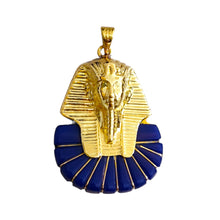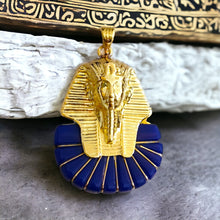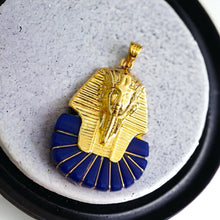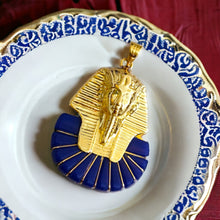
"Discover the regal allure of the King Tut Ankh Amon Pharaoh Mask Gold Pendant Necklace. Crafted with exquisite detail, this pendant pays homage to the legendary Egyptian pharaoh. Experience timeless elegance with a touch of history. Shop now!"
- History: Inspired by ancient Egyptian culture, particularly the reign of King Tutankhamun.
- Spiritually: Represents life, immortality, and power, embodying the divine.
- Talisman: Thought to bring protection, prosperity, and spiritual connection.
- Handmade: Crafted with care and precision, ensuring each piece is unique.
- Healing: Believed to promote physical and spiritual well-being, aiding in inner strength.
- Material Gold: Made from high-quality gold, symbolizing wealth, purity, and eternity.
- Symbolism: An amalgamation of Egyptian royalty, symbolizing authority and legacy.
- How to Wear: Fits any chain up to 5mm, allowing for versatile styling and personalization.
- Ideal Gift: Perfect for those drawn to ancient history, spirituality, or seeking symbolic jewelry.
History Side For Those Who Are Interested
The Egyptian King Tutankhamun's Golden Mask is one of the most iconic artifacts from ancient Egypt. Here's a professional and accurate history:
Crafted during the 18th dynasty of ancient Egypt, specifically during the reign of Pharaoh Tutankhamun, the Golden Mask holds a significant place in both Egyptian history and global archaeology. Tutankhamun, who ascended to the throne around 1332 BCE at the tender age of nine, ruled during a period known as the New Kingdom, a time of immense cultural, political, and military prosperity in ancient Egypt.
The mask was likely created to accompany Tutankhamun's mummified remains in his tomb, located in the Valley of the Kings near modern-day Luxor. Its purpose was to protect the pharaoh's face in the afterlife and to ensure his immortality. Crafted from solid gold, the mask stands as a testament to the advanced craftsmanship and artistry of ancient Egyptian artisans.
The mask itself depicts the youthful visage of King Tutankhamun, with finely detailed features and delicate proportions. Adorned with intricate designs and symbolic imagery, including the traditional royal nemes headdress and the protective cobra and vulture representing Lower and Upper Egypt respectively, the mask encapsulates the religious and cultural beliefs of ancient Egyptian society.
Following Tutankhamun's death, his tomb lay undisturbed for over 3,000 years until its discovery by British archaeologist Howard Carter in 1922. The unveiling of the tomb and its treasures, including the Golden Mask, sparked worldwide fascination and renewed interest in ancient Egyptian civilization.
The Golden Mask of Tutankhamun has since become an enduring symbol of ancient Egypt's rich cultural heritage and a revered artifact in the field of archaeology. Today, it remains a prized exhibit in the Egyptian Museum in Cairo, where it continues to captivate visitors from around the world with its timeless beauty and historical significance.

















